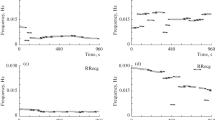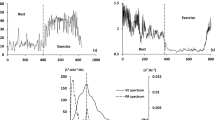Summary
The ventilatory response to sinusoidally varying exercise was studied in five adults and seven prepubertal children to determine whether the faster kinetics of ventilation observed in children during abrupt changes in exercise intensity remained more rapid when exercise intensity varied continuously. Each subject exercised on a cycle ergometer first against a constant load and then against a load fluctuating over six different periods ranging from 0.75 to 10 min. The pedal rate was kept constant for all loads. The inspiratory minute ventilation was determined breath-by-breath. Amplitude (A) and phase angle (ϕ) of the fundamental component and the first harmonics of the ventilatory response were calculated by Fourier analysis for an integer number of waves for each period. From the relationship between A, ϕ and frequency, dynamic parameters of a first order model with and without delay were compared between adults and children. Firstly we found that the ventilatory time constant was significantly faster in children: 49.7 (SD 9.1) s vs 74.6 (SD 11.1) s (P<0.01). Secondly, the change in A and ϕ with the frequency was not however characteristic of a first order system without delay in most of the subjects ϕ > 90° for the shorter periods). Thirdly, even when the ventilatory control system was described as a first order model with a positive delay, time constants remained significantly shorter in children: 45.6 (SD 5.7) s vs 67.4 (SD 13) s (P<0.01). The ability to increase ventilation faster in children appeared to be a characteristic of the ventilatory control system during exercise independent of the type of drive used.
Similar content being viewed by others
References
Bakker HK, Struikenkamp RS, De Vries GA (1980) Dynamics of ventilation, heart rate, and gas exchange: sinusoidal and impulse work loads in man. J Appl Physiol 48:289–301
Beaver WL, Wasserman K, Whipp BJ (1986) A new method for detecting anaerobic threshold by gas exchange. J Appl Physiol 60:2020–2027
Bennett FM, Reischl P, Grodins FS, Yamashiro SM, Fordyce WE (1981) Dynamics of ventilatory response to exercise in humans. J Appl Physiol 51:194–203
Casaburi R, Whipp B, Wasserman K, Beaver WL, Koyal SN (1977) Ventilatory and gas exchange dynamics in response to sinusoidal work. J Appl Physiol 42:300–311
Casaburi R, Barstow TJ, Robinson T, Wasserman K (1989) Influence of work rate on ventilatory and gas exchange kinetics. J Appl Physiol 67:547–555
Cooper DM, Kaplan MR, Baumgarten L, Weiler-Ravel D, Whipp BJ, Wasserman K (1987) Coupling of ventilation and CO2 production during exercise in children. Pediatr Res 21:568–572
Dejours P (1964) Control of respiration in muscular exercise. In: Fenn WO, Rahn H (eds) Handbook of physiology. Respiration, section 3, vol. 1, chap. 25. American Physiological Society, Washington D.C., pp 631–648
Engeman RM, Swanson GD, Jones RH (1981) Sinusoidal frequency allocations for estimating model parameters. IEEE Trans Syst Man Cybern 11:243–245
Engeman RM, Swanson GD, Jones RH (1983) Optimal frequency locations for estimating model parameters in studies on respiratory control. Comput Biomed Res 16:531–536
Farebrother RW (1988) Linear least square computation. Dekker, New York, pp 217–227
Flandrois R, Grandmontagne M, Mayet MH, Favier R, Frutoso J (1980) Adaptation cardio-respiratory au début de l'exercice musculaire chez l'enfant. In: Lavalée H, Shephard RJ (eds) Symposium international croissance et développement de l'enfant, pp 319–330
Fujihara Y, Hildebrandt J, Hildebrandt JR (1973) Cardiorespiratory transients in exercising man. II. Linear models. J Appl Physiol 35:68–76
Greco EC, Baier H, Saez A (1986) Transient ventilatory and heart rate responses to moderate nonabrupt pseudorandom exercise. J Appl Physiol 60:1524–1534
Griffiths TL, Henson LC, Whipp BJ (1986) The influence of inspired O2 concentration on the dynamics of the exercise in man. J Physiol (Lond) 380:387–403
Linnarsson D (1974) Dynamics of pulmonary gas exchange and heart rate changes at start and end of exercise. Acta Physiol Scand [Suppl] 415:1–68
Springer C, Barstow T, Cooper D (1989) Effect of hypoxia on ventilatory control during exercise in children and adults. Pediatr Res 25:285–290
Tanner JN (1955) Growth at adolescence. Blackwell, Oxford
Tong H (1990) Non-linear time series: a dynamical system approach. Oxford University Press, Oxford, pp 215–344
Ward SA, Whipp BJ, Koyal SN, Wasserman K (1983) Influence of body CO2 stores on ventilatory dynamics during exercise. J Appl Physiol 55:742–749
Ward SA, Blesovsky L, Russak S, Ashjian A, Whipp B (1987) Chemoreflex modulation of ventilatory dynamics during exercise in humans. J Appl Physiol 63:2001–2007
Wasserman K, Whipp BJ, Koyal SN, Cleary MG (1975) Effect of carotid body resection on ventilatory and acid-base control during exercise. J Appl Physiol 39:354–358
Wasserman K, Whipp BJ, Casaburi R (1986) Respiratory control during exercise. In: Macklem PT, Mead J (eds) Handbook of physiology. The respiratory system, vol II, part 1, chap. 17. American Physiology Society, Bethesda, Md., pp 595–619
Whipp BJ, Ward SA, Lamara N, Davis JA, Wasserman K (1982) Parameters of ventilatory and gas exchange dynamics during exercise. J Appl Physiol 52:1506–1513
Wigertz O (1970) Dynamics of ventilation and heart rate in response to sinusoidal work load in man. J Appl Physiol 29:208–218
Author information
Authors and Affiliations
Rights and permissions
About this article
Cite this article
Haouzi, P., Fukuba, Y., Peslin, R. et al. Ventilatory dynamics in children and adults during sinusoidal exercise. Europ. J. Appl. Physiol. 64, 410–418 (1992). https://doi.org/10.1007/BF00625059
Accepted:
Issue Date:
DOI: https://doi.org/10.1007/BF00625059




